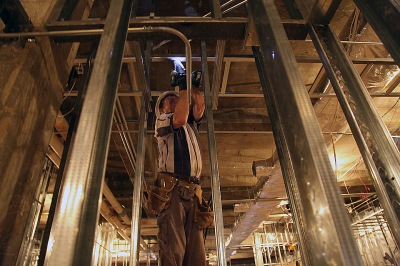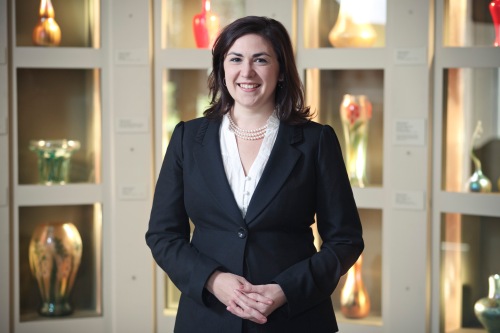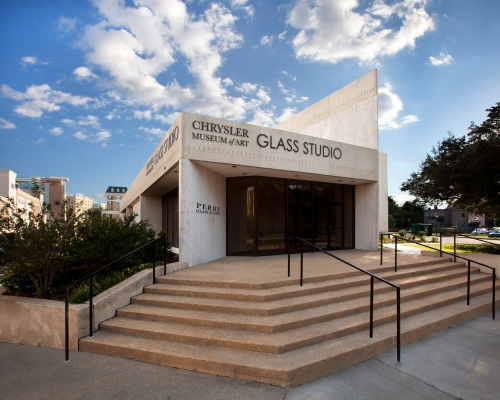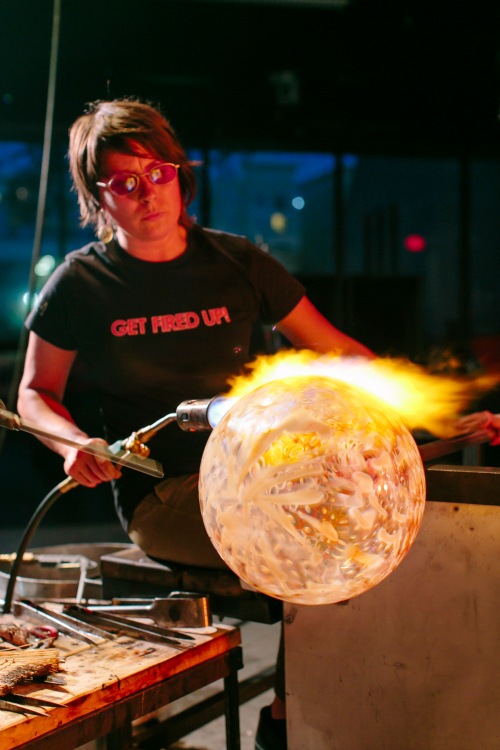 A scene from the construction site, where the new Chrysler Museum of Art is being reshaped. courtesy: chrysler museum of art
A scene from the construction site, where the new Chrysler Museum of Art is being reshaped. courtesy: chrysler museum of art
Under the current expansion and renovation of the main building, the Chrysler Museum of Art in Norfolk, Virginia has announced a 30-percent increase in its glass collection that will be on display, as well as greater connections to the activities of its glass studio. The museum’s soon-to-be-completed $45 million capital campaign—which sponsored the new glass studio that opened in November 2011—is also financing this $24 million project that is expected to open to the public in April 2014.
In total, the 210,000-square-foot interior is gaining an additional 10,000 square feet, which museum officials hope will enable more flexible exhibition spaces and encourage visitors to choose their own pathways from one space to the next. The front facade of the museum will remain preserved, though two new wings will flank the front entrance.
The museum also announced it is strategically redesigning the layout of the permanent collection, which consists of approximately 30,000 objects spanning 5,000 years of history. The collection was attained primarily from the avid collector, the late Walter Chrysler, Jr.
“Our building project is the latest component of the Chrysler’s ongoing commitment to providing our visitors with experiences that delight, inspire, and transform,” Bill Hennessey, director of the museum, explained in a prepared statement. “We began by adopting free admission, by retraining our security staff as Gallery Hosts, by rethinking fundamentally the way we present and interpret our collections, and by creating our dynamic Glass Studio. Now our community and visitors to Norfolk will be able to enjoy our extraordinary collection in beautifully expanded and modernized galleries.”
 Kelly Conway, the museum’s Carolyn and Richard Barry curator of glass, is pictured before the Tiffany Gallery. photo: echard wheeler. courtesy: chrysler museum of art
Kelly Conway, the museum’s Carolyn and Richard Barry curator of glass, is pictured before the Tiffany Gallery. photo: echard wheeler. courtesy: chrysler museum of art
The former glass galleries have been demolished and expanded from the ground up; the revitalized glass collection will now be prominently displayed on the first floor. Kelly Conway, the museum’s Carolyn and Richard Barry curator of glass—who, it has been recently announced, will be the new curator of American glass at the Corning Museum of Glass—explained in an email exchange with the GLASS Quarterly Hot Sheet, that the “goal is to make glass more visible and to enliven the space through physical re-installation—perfecting everything from the floor to the wall colors—and how it corresponds to the actual visual interpretation of the glass.”
While one floor will house an entire collection of modern and contemporary 20th century glass pieces, the first-floor collection starts off with a less-complex “introductory gallery” that will provide some necessary background information. It will focus on outlining the essential processes answering the most popular question the museum receives: How is glass made?
 The exterior of the museum’s glass studio. credit: ed pollard.
The exterior of the museum’s glass studio. credit: ed pollard.
courtesy: chrysler museum of art.
Before the renovation, Conway mentioned how visitors would immediately flock over to the studio from the museum collection, and conversely, artists in the studio would frequently visit the permanent collection. Under the current construction, new landscaping will connect the main building to the studio, which the museum hopes will cultivate a smooth transition between the two places and fortify the connections between the finished pieces and the works-in-progress. The museum galleries are also incorporating a live feed of demonstrations in the studio—which has high-tech equipment, including large screens and cameras along with kilns operated by iPhones.
 Charlotte Potter (pictured here) is the studio manager of the museum’s glass studio. photo: echard wheeler. courtesy: chrysler museum of art.
Charlotte Potter (pictured here) is the studio manager of the museum’s glass studio. photo: echard wheeler. courtesy: chrysler museum of art.
“People learn in different ways, and the message is given in different formats to teach it to different visitors,” Conway explained regarding the museum’s comprehensive approach.
In terms of the freshened curation of the collection, Conway has explained that the curators of the museum’s various collections are working collaboratively to adopt a holistic approach, in which artworks are not being categorized in the traditional manner of period and chronology, but through thematic inserts.
“We are trying to break that chronological flow in a meaningful way,” Conway stated. She cited the Neo-Classical piece, Reclining Dress Impression (2005) by contemporary artist Karen LaMonte, as an example of a glass artwork that has been placed out of its chronology and within the ancient Greek and Roman gallery for cross-temporal enrichment.
Conway has also been working with non-Western works, which she believes will enhance the overall context of the glass collection. For instance, the Tiffany collection will showcase the influence of Japanese and Byzantine decorative arts. The influence of Chinese porcelain may also be included.
When the Hot Sheet inquired further about this curatorial approach, Conway explained that it is all about gaining an expanded audience by revealing the stories behind the pieces and providing comparisons to other times and cultures. The people involved, the environments and societies they lived in, the trade routes used, and the politics of the time are examples of topics explored.
“Glass is a very approachable material. Everyone encounters it in their everyday lives. Art historically, it is very utilitarian—it’s not unknown to people when they come in—and there are a lot of back stories,” Conway stated. Providing those back stories “helps connect people of today with people of the past. It makes the past come alive more today.”
—Gina DeCagna


